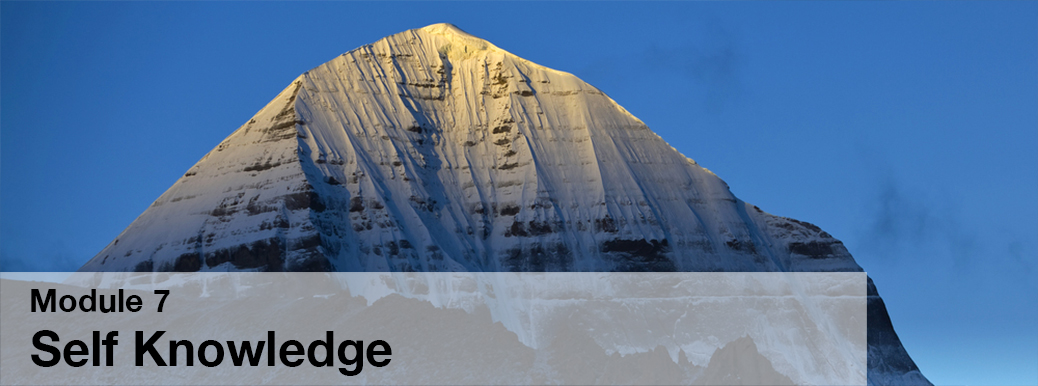Introduction
In this chapter we will take a look at the “3 Bodies” (Sharira Trayam) teaching of Vedanta. An individual is called a “Jiva” in Vedanta. According to Vedanta a Jiva is composed of 3 bodies.
These 3 bodies are:
- Gross Body (Sthula Sharira)
- Subtle Body (Sukshma Sharira)
- Causal Body (Karana Sharira)
While analysing each body we will study the 4 factors associated with each body. These 4 factors are:
- The Material out of which each body is made.
- The Components in each body.
- The Function of each body.
- The Nature of each body.
I. The Gross Body
1. Material
The scriptures say that the Gross Body is made out of gross matter, which in turn is in the form of 5 gross elements. Gross Matter is composed of 5 gross elements:
- Space
- Air
- Fire
- Water
- Earth
That a human body is composed of these 5 elements can easily be proved by analysis. A human body occupies space, has fire element in the form of body temperature, has air element in the form of life breath, has a significant amount of water within it, and has earth element to give it solid form.
2. Components
3. Function
The rent payment is in the form of Karma; both good Karma (Punya) & bad Karma (Papa). As long as there is Karma waiting to fructify, the body is available.
If there is no more Karma, then there is no reason for the Jiva to keep occupying a body.
Therefore a body is a temporary residence we use to transact with the world.
4. Nature
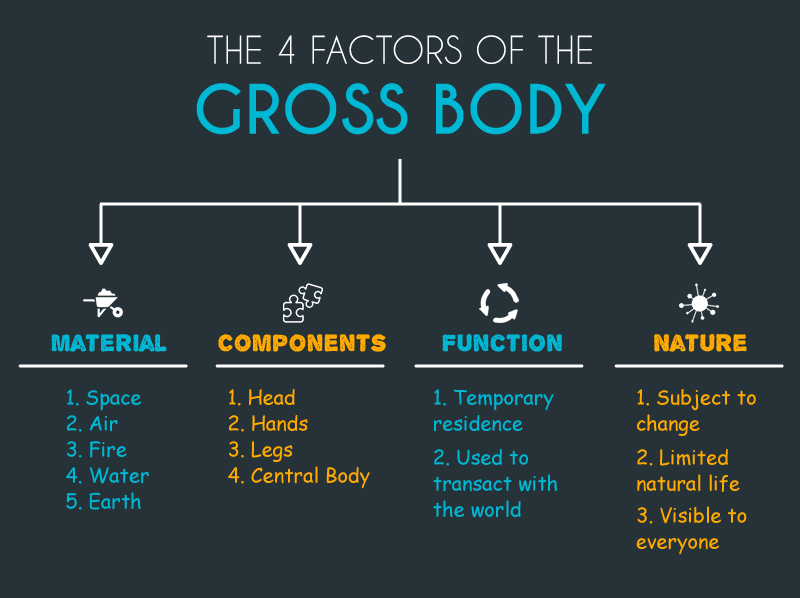
II. The Subtle Body
1. Material
- Subtle Space
- Subtle Air
- Subtle Fire
- Subtle Water
- Subtle Earth
So even though the elements are subtle, the subtle body is material in nature.
2. Components

a. The 5 Sense Organs of Knowledge
The subtle body is the instrument of perception. The points on the physical body where sense perception seems to occur are not the actual sense organs. Perception is only possible when the mind is behind the sense organ.
The eyes may be open but the visual data received from the eyes will have no meaning if the mind is day dreaming or occupied elsewhere.
b. The 5 Organs of Action
These 5 organs of action are: speech, hands, legs, anus & genitals.
c. The 5 Pranas
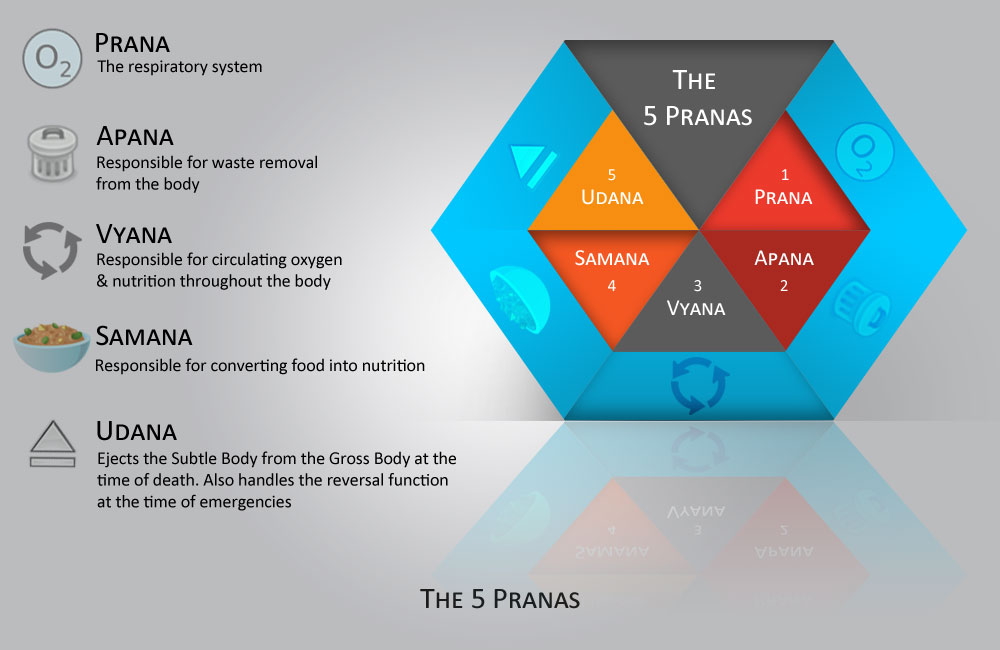
e. The 4 Internal Organs
Another function of the mind is to act as the doubting faculty. For e.g. “Should I do this, or should I do that?”
The intellect gathers knowledge, remembers, analyses, inquires into problems and discriminates. From the enlightenment perspective intellect is the most important aspect of the subtle body since liberation is nothing but removal of ignorance from the intellect.
Sometimes even memories from past lives can be remembered by the mind. For e.g. a musical prodigy feels that she knows the music even though she is hearing it for the first time or a spiritual prodigy feels that he has learnt the scriptures before.
The term Ego can be a very misleading term. In the modern spiritual world, the term Ego can mean a lot of things. So to clarify the meaning of Ego in Vedanta, we have included a section at the end of the chapter.
When through inquiry, self-knowledge arises in the intellect, it destroys this “I”, freeing the ever-free awareness from its apparent limitations.
3. Function
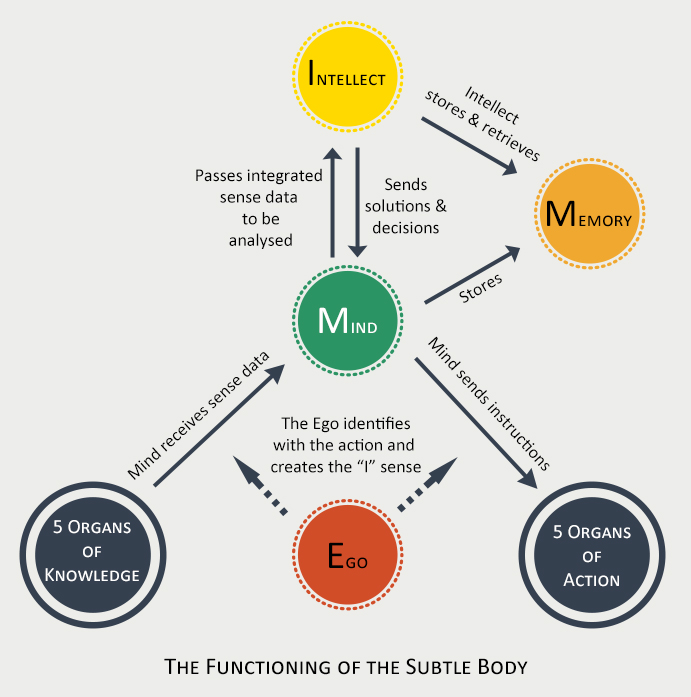
In the above diagram we can see a detailed explanation of how the Subtle Body functions internally in response to stimuli from the external world.
These are the steps:
Liberation or Moksha is nothing but the ability to observe the Ego dispassionately and impersonally; not identifying with the Ego, and seeing that everything is happening on its own. The Subtle Body is an inert mechanism which performs various functions when illumined by Awareness.
As we mentioned in the Knowledge vs Experience chapter, the Ego need not be killed, nor can it be killed. We just need to stop identifying with the Ego as our real identity, and to make Awareness our primary identity.
Swami Paramarthananda says that we need to convert our “identification” with Ego to an “association”. Because I can observe the Ego, I am “associated” with it, but since I am not the Ego, I should not be “identified” with it.
Enlightenment and the Intellect
The 4 internal organs can collectively be called the Mind. It is important to understand that the 4 internal organs – Mind, Intellect, Memory and Ego – are not actual divisions within the Mind; these are functional divisions. The Mind is called 4 different names based on the function it performs.
Ignorance resides in the Intellect. The Intellect is where you have all the ideas about yourself. The Intellect thinks it is not Awareness.
So enlightenment is making the thought “I am Awareness” hard and fast in the Intellect. This thought is called Akhandakara Vritti. Once this knowledge operates through the Intellect without any misconceptions, suffering based on limited ideas about yourself will end.
The Value of a Clear Mind
The Amritabindu Upanishad says:
The mind is, verily, the cause of bondage as well as liberation; engrossed in objects of sense, it leads to bondage; free from attachment to objects, the same mind leads to liberation.
This is why Vedanta places such a heavy emphasis on preparing the Mind. Karma Yoga, Upasana Yoga and Universal Values are all important to acquire a calm, tranquil mind; a mind conducive for Self-Inquiry.
4. Nature
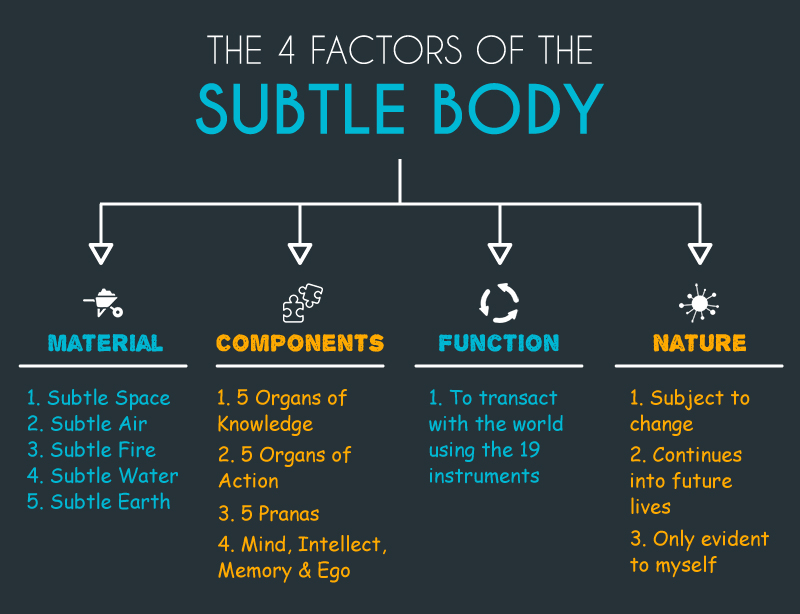
III. Causal Body
1. Material
2. Components
It is similar to a tree sprouting from within a seed, where it existed in potential or un-manifest form.
Matter can never be produced or destroyed. Matter always exists. So before creation too the Subtle and Gross Bodies must have existed in potential form. That potential form is called the Causal Body.
So the Causal Body evolves into the Subtle and Gross Body, just as a seed evolves into a tree.
3. Function
4. Nature
Also, the Gross Body is visible to everyone, the Subtle Body is known only to me, but the Causal Body is not evident even to myself. Since the Causal Body is more subtle than the mind, it is not known even to me.
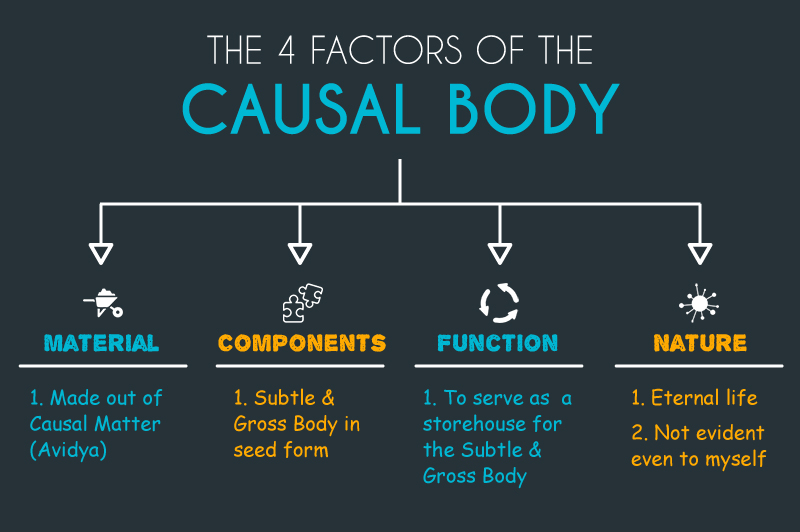
A note on Vasanas
What are Vasanas?
When we act from a feeling of lack (fear) and the desire that springs from it, the action leaves a subtle trace. The unseen result is called a Vasana. The literal meaning of Vasana in Sanskrit is a fragrance. Like the fragrance emitted by a flower, the actions taken by us carry on unbeknownst to us.
For e.g. a certain experience gives you pleasure. When the experience is over physically, it is still no over. You may go about your business and seemingly forget about the experience, but a Vasana for that experience has been created in your mind. When you find yourself in a situation to have that same experience, you want it once more. The desire for objects that lie hidden in us and spring out from time to time are our Vasanas.
This applies to fear as well. When you have a bad experience, you will try to avoid that kind of experience like a plague.
Vasanas are your conditioning, your tendencies, the objects and activities that you are attracted to and repelled by.
Everything that moves in the world is driven by Vasanas. Vasanas are not inherently good or bad. They are the seeds (knowledge) that drive creation.
A Vasana is a momentum from past action, the tendency to repeat it. It is just a technical term. There are positive Vasanas, and there are negative Vasanas.
The belief that all Vasanas are negative has given rise to the erroneous idea that enlightenment happens when all the Vasanas are removed. Enlightened people also have Vasanas. If you’re alive, you have Vasanas.
Binding Vasanas
I am no longer eating to sustain my body, but to distract myself from my emotional pain. I have perverted my food Vasana.
When a Vasana is constantly repeated, the behaviour associated with it becomes binding. The Vasana-driven habit becomes an obsession or a compulsion which finally morphs into an addiction. These are called “binding” Vasanas.
This vicious cycle can be illustrated in this way: Vasana –> Kama (Desire) –> Karma (Action) –> Vasana. A Vasana gives rise to a desire (Kama), the desire causes us to act (Karma), the action in turn reinforces the Vasana, and the cycle keeps repeating.
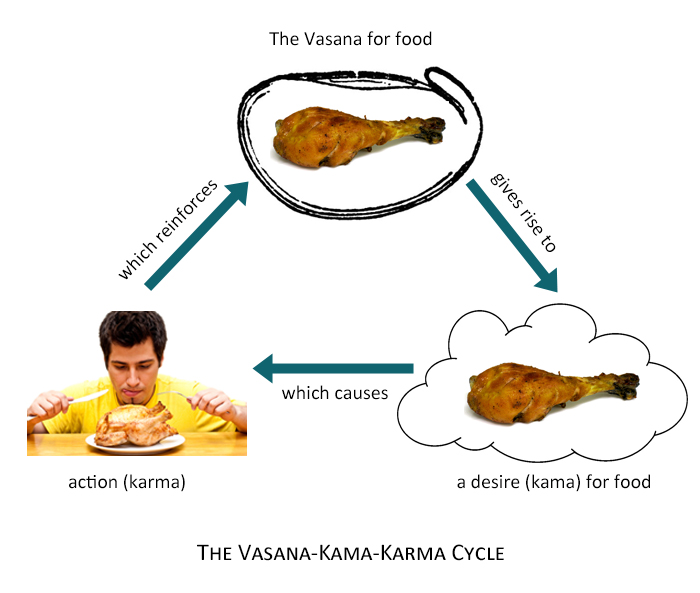
So an enlightened person does not need to get rid of all his Vasanas; he just needs to make all his binding Vasanas non-binding, so that the Vasanas no longer dictate his actions.
Location of Vasanas in the Jiva
Further Clarification on Ego
Vedanta has 3 basic concepts regarding the Ego:
1. Jiva
2. Ahamkara
Ahamkara is not an independent volitional entity; it is simply the notion that I am a separate individual entity, and the consequent belief that I am a doer and an enjoyer/experiencer.
It is the one who claims responsibility for all the decisions the intellect makes, and all the actions the mind and the body take.
In more specific terms, Ahamkara is the plethora of ideas the apparent individual has about himself or herself such as “I am a male or female; I am black or white; I am fat, skinny, healthy, sick, artistic, business-minded, pragmatic, neat, messy.”
As James Swartz says, the world is a super market of identities. And the ego is that aspect of the apparent person that identifies with these identities, and defines itself in terms of them.
3. Abhimanam
It is the definition of the ego that is closest in meaning to the common Western definition of ego as “self-importance” or “conceit”.
Though it does not necessarily connote an attitude of arrogance, Abhimanam does suggest a feeling of pride associated with one’s possession of particular objects, be they tangible items, physical characteristics and skills, mental acuity and creativity or personal experiences and accomplishments.
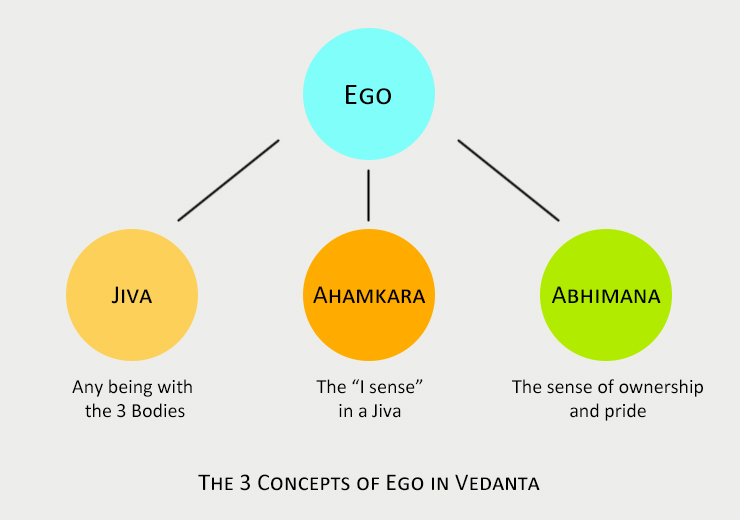
In all three cases, there is a sense of a personal identity, a sense of being an “I” who is separate from and different than other “I”s. In Vedantic terms, this sense of separation is the essence of egoism.
Vedanta says that it is the sense of separation that needs to be transcended, not the sense of egoism per se. In other words, while the association with the mind-body-sense complex will continue, one needs to cease identifying oneself in terms of it.
One needs to understand that despite appearances to the contrary, all forms are essentially nothing other than Awareness, the singular “substanceless substance” that is the substratum (Adhishthanam) supporting the entire manifestation.
Transcending the ego is entirely a matter of understanding.
The Ahamkara is necessary in order to allow the individual the ability to function as a discrete entity within the dualistic apparent reality.
If the individual wasn’t equipped with the sense of duality, he wouldn’t even be able to find the door through which to leave his house in the morning, much less be able to drive a car or take care of business at his place of employment.
And if he isn’t able to tell himself apart from other entities, he wouldn’t even know what mouth he was supposed to feed when he felt hungry, much less be able to play with his dog or interact with his friends and family.
Moreover, you need a highly refined intellect and healthy sense of “I” in order to engage in effective self-inquiry, and make the discrimination between the Self and the “not-Self” that facilitates the assimilation of Self-knowledge and the “attainment” of ultimate inner freedom.
Ironically, you need the ability to effectively operate the instrument of the apparent individual person in order to eradicate your identification with it.
Is transcending the ego same as ego death?
When you understand that you are whole, complete, perfect, pure, limitless, attribute-less awareness and that as such no apparent object or experience can enhance, diminish or otherwise affect your essential nature in any way, then you are free.
Through the instrument of the mind-body-sense mechanism that constitutes the apparent individual person you seem to be, you will still encounter the ups and downs that characterize the drama of life.
However, while the experience of pain and pleasure persists, suffering ceases once and for all.
One’s association with the mind-body-sense complex therefore need not and, for that matter should not, be eradicated. Self-realization does not mean dissociative identity disorder or death; but one’s identification with the body-mind-sense complex should be negated through the assimilation of self-knowledge.
Summary
| 1. | The Gross Body is made out of the 5 gross elements: space, air, fire, water and earth. The scriptures divide the Gross Body into 4 components: head, hands, legs and central body. The purpose of the Gross Body is to transact with the external world. The Gross Body has limited natural life; when the Karma for a body ends, it dies. |
| 2. | The Subtle Body is composed of the 5 elements in their subtle form: space, air, fire, water and earth. You can call the Subtle Body the engine for the Gross Body. It runs the various physiological functions of the body. The Subtle Body receives sense data from Gross Body, processes the data, and tells the body how to respond to the external world. |
| 3. | There are 19 instruments in the Subtle Body: the 5 organs of knowledge, the 5 pranas, the 5 organs of action and the 4 internal organs (collectively called the Mind). We saw the significance of the Mind from the enlightenment perspective. Why it is important to cultivate a tranquil mind. The Subtle Body has a longer life compared to the Gross Body because it continues into future lives. |
| 4. | The Causal Body is made out of Causal Matter and contains the Subtle and Gross Body in seed form. The Causal Body is indestructible and survives even the dissolution of the Universe, to again sprout the Subtle and Gross Body during the next creation cycle. |
| 5. | We also covered the topic of Vasanas. Vasanas are both the source of action (karma) and the unseen result of action. All desires and fears are nothing but subconscious tendencies in our mind. When we act out these tendencies, they reinforce the Vasanas. There are both negative as well as positive Vasanas. To become enlightened we don’t need to get rid of all Vasanas, we just need to render the binding Vasanas non-binding. |
| 6. | Finally the topic of ego was covered. We learned about the 3 different concepts of ego in Vedanta – the Jiva, Ahamkara and Abhimanam. We saw how transcending the ego is not the same as “ego death”, which seems to be widely propagated in the modern spiritual world. An enlightened person also has an ego, but he or she does not identify with it. |
